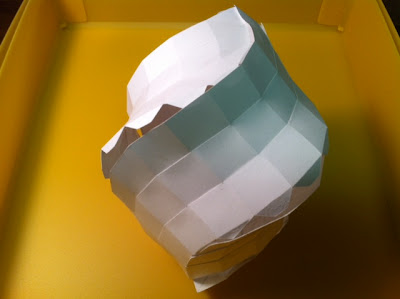One of the first things that we tried to cut with the Craft ROBO Pro was, of course, a
Sierpinski carpet. After much frustration and mixed results (extra cut lines, not getting through the paper, bad corners, etc), we let the Replicator 2 have a try. Instead of cutting from thick paper, we printed something thin. The designs below were made in
Tinkercad and exported to .stl for the 3d printer. These two things are models of the same object except that the one in the upper right is thicker and it is more difficult to see its smallest holes because of a raft catastrophe. (Don't print a raft under something with such a large flat bottom area; at least with the settings I used, it is impossible to pull off the raft afterwards. In this case the raft is obscuring the smaller holes in the object.) These objects are also the same as the top slice of a
Level 3 Menger sponge. The large one is 1 mm thick and the smaller one is 4 mm thick.
The 1 mm thickness of the larger object above makes it a little like a thin coaster. It's sturdy but quite thin - about the thickness of a dime. Actually, because of the ridges and lines from the 3D printing extrusion process on the top of the model, the thickness is between 1 and 1.4 mm, depending on where you measure it.
So how thin can we print with the Replicator 2, and how accurate are those thin prints? The models below were made in Tinkercad (so easy: just drop in a cube, change the height, drop in a number and center it in the square, make the number a "hole", and group the square with the number hole). The numbers indicate the height, in millimeters, of the model.
The Replicator 2 is amazing. Although the thicknesses range in general from 90% to 130% of what they were meant to be, they do get measurably smaller as the numbers decrease, and the 0.1 mm model actually does measure 0.1 mm in many places. The 0.1 mm square is so thin that it is flexible and almost transparent even though we used black filament. A tenth of a millimeter is 100 microns, and the period at the end of this sentence is probably about 600 microns high.
.JPG)
.JPG)
.JPG)
.JPG)













